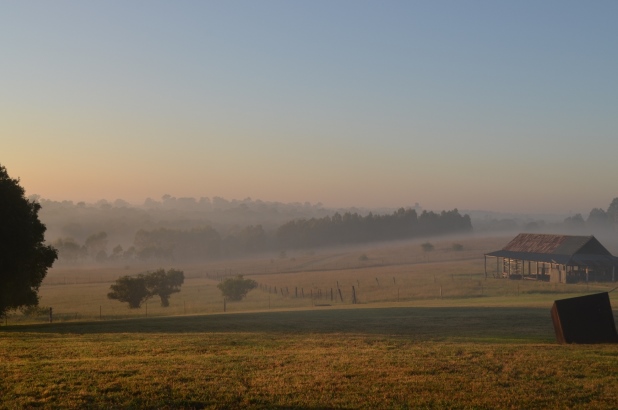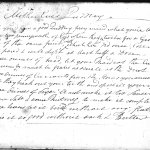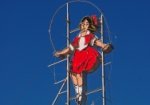This winter, as the sun sets over the cows and farm paddocks at Rouse Hill, it’s hard not to wax lyrical over the picturesque, bucolic scene. Hang on, over the… what now?
The pastoral tradition
The Western tradition of depicting an idealised, sentimental and even romantic rural life in poetry and art is ancient, and entrenched. The canon began with the ancient Hellenistic Greeks, and in the works of Theocritus (the Idylls) and later poets such as the Romans Horace (the Epodes)and Virgil (the Georgics and Eclogues) it would become a firmly established trope.
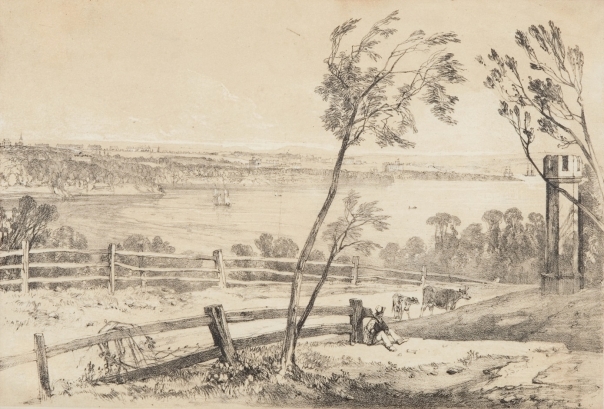
J S Prout; Harbourside scene with cattle and cowherd. Caroline Simpson Collection, Sydney Living Museums
In viewing an idealised rural life as being less complex than city life, and more in tune with nature it of course (but very poetically) overlooks the sheer hard work that farm life requires! Pastoral artworks traditionally showed shepherds listlessly reclining while their flocks ambled about picturesquely – the Macarthurs’ herdsmen would have a very different view as they trudged about the Cowpastures. As the temperatures plummeted in winter and soared in summer, I’m sure the Rouse’s farmhands weren’t feeling all that prone to burst into a quick eclogue or two – no matter how well versed Edwin Steven Rouse was in Latin and Greek!
Often the Roman take on the pastoral theme set about contrasting the merits and morals of the city and the country life (remember the ‘Tale of the Town Mouse and the Country Mouse’? That’s by Horace). Many who remember the TV show Green Acres don’t realise its a variation of a 2,500 year old that the Romans would recognise:
Green Acres is the place to be
Farm livin’ is the life for me
Land spreadin’ out so far and wide
Keep Manhattan, just give me that countryside!New York is where I’d rather stay
I get allergic smelling hay
I just adore a penthouse view –
Darling I love you but give me Park Avenue! [‘Green acres’ lyrics by Vic Mizzy]
Hanging out in a paddock, with Phyllis and Daphnis
Characters in the classical pastoral poems it seems are all called Amaryllis, Tityrus, Daphnis, Phyllis, or Corydon. Of course I exaggerate, but there don’t seem to be many names to go around in Arcadia, Sicily or rural Latium, or else the same shepherds are all very busy competing in perpetual poetry contests.
In this excerpt from Theocritus’ Idylls, Daphnis, a very self-assured shepherd, paints a picture of a rustic paradise:
Sweet is the chorus of the calves and kine,
And sweet the herdsman’s pipe. But none may vie
With Daphnis; and a rush-strown bed is mine
Near a cool rill, where carpeted I lie
On fair white goatskins. From a hill-top high
The westwind swept me down the herd entire,
Cropping the strawberries: whence it comes that I
No more heed summer, with his breath of fire,
Than lovers heed the words of mother and of sire.from Theocritus, The Idylls IX: ‘A Pastoral’. From C.S. Calverley, Theocritus; translated into English verse. London, 1892
In the Renaissance the pastoral tradition blossomed (boom-tish). On of the best known English poems is Christopher Marlowe’s The Passionate (and clearly cashed-up) Shepherd to His Love (published 1599). The imagery is the same as Theocritus:
Come live with me and be my love,
And we will all the pleasures prove,
That Valleys, groves, hills, and fields,
Woods, or steepy mountain yields.And we will sit upon the Rocks,
Seeing the Shepherds feed their flocks,
By shallow Rivers to whose falls
Melodious birds sing Madrigals…A gown made of the finest wool
Which from our pretty Lambs we pull;
Fair lined slippers for the cold,
With buckles of the purest gold;…The Shepherds’ Swains shall dance and sing
For thy delight each May-morning:
If these delights thy mind may move,
Then live with me, and be my love.
Cows and calves! So ‘bucolic’!
Bucolic? No, that’s not a chest infection. We often hear visitors to Rouse Hill enthusing over the ‘pastoral’ scenery, more rarely of the ‘bucolic’. They almost mean the same thing: a pastoral scene is one where domestic animals such as sheep or cattle are depicted in pastureland, ideally with a shepherd or farmer in attendance. To explain, pastor is the Latin for shepherd.
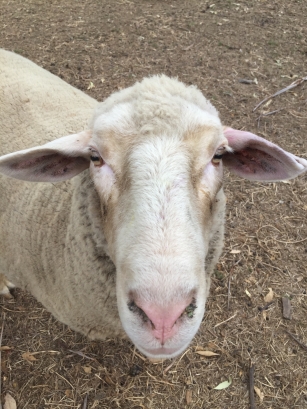
A candidate for a pastoral view at Rouse Hill House. Photo (c) Scott Hill for Sydney Living Museums
While it seems very European, the pastoral theme was widely used in portraying and depicting colonial farmland. For the educated colonial gentry in NSW classical allusions abounded: merchant Brodie Spark, who had previously lived at Tusculum, named for Cicero’s country retreat, even named his riverside estate ‘Tempe House’, after the Vale of Tempe, supposedly the most beautiful in Greece.
This view by Conrad Martens of Hannibal Macarthur’s Vineyard has a scattering of sheep, and the appropriately listless shepherd at right, with the actual subject rising like a sun-drenched, classical villa in the background:
The house at Vineyard Parramatta_ Conrad Martens 1856_Caroline Simpson Library & Research Collection, Sydney Living Museums
A ‘bucolic’ scene – from the Greek bous, cow, and boukolos meaning cowherd or herdsman – is specifically one with cattle, such as in this autumnal painting from Meroogal:
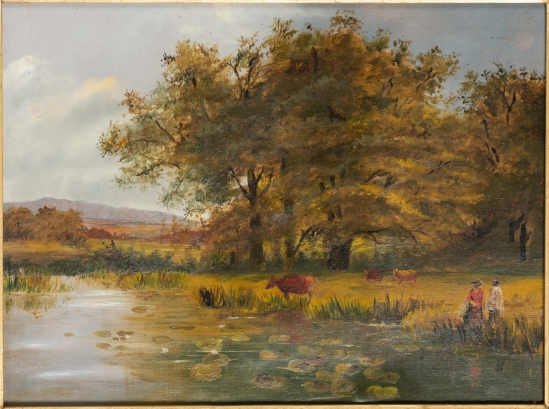
Oil on canvas landscape painting of bucolic country scene, ca 1900. Meroogal collection, Sydney Living Museums
Note the very relaxed figures at right.Very bucolic.
So why do we have the cows at Rouse Hill, and what is their history?
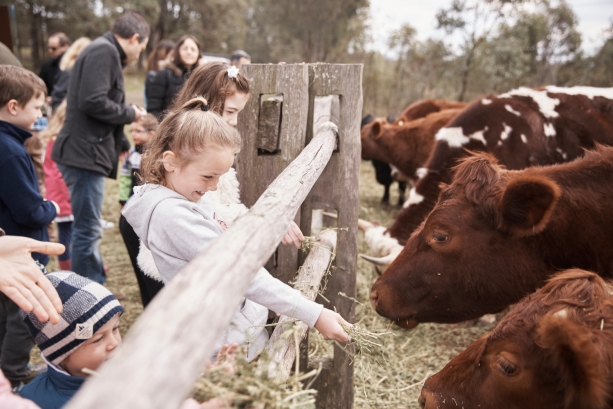
Feeding the cattle at Rouse Hill at the Toy Festival 2016. Photograph (c) Stuart Miller, for Sydney Living Museums
A highlight of the Autumn Harvest and Family Festival events at Rouse Hill is the opportunity to get up close with the cattle. (If you’re lucky you wont get sneezed on like I was one year – its a revolting experience, a cow’s sinus must be the size of a football…) At Rouse Hill we seek to preserve the property, the buildings and landscape as it was in 1978. That includes maintaining a small herd of Hereford cattle (a few Limousine cattle have crept in), just as the Terrys ran on the property in the 70s. Similarly we keep chickens, reflecting the chooks kept for eggs and meat. Its an ever present reminder that the property has a long history as a working farm.
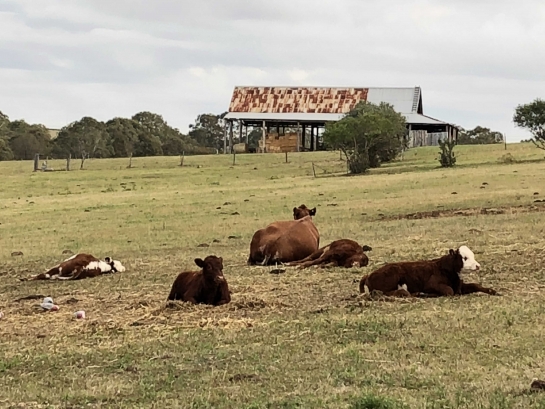
Sleepy cows at Rouse Hill. Photo (c) Scott Hill for Sydney Living Museums
This isn’t a great photo as I couldn’t get to close without spooking the 4 calves – all sprawled about in the late afternoon last week. In the background you can see piles of hay-bales in the 1850s barn: currently we are feeding the cows as the months of drought has left us with almost no pasture. They are rotated through the paddocks frequently to give the grass as much of a breather as possible.
Rouse Hill House Family Fair, 2018
Feeling bucolic? You can get into the pastoral spirit at the Rouse Hill House & Farm Family Fair on Sunday, 12th August 2018. There are pony rides, sheep shearing, baby animals, and you can get into the bucolic mood by feeding the cows! Full details online here.
To finish, here’s the glorious sunset panorama at Rouse Hill last week:

Rouse Hill looking west to the mountains at sunset. Photo (c) Scott Hill for Sydney Living Museums
Second helpings
This of course is a light-hearted explanation of what is a far more complex topic. If pastorals and bucolics have grabbed your interest I can recommend a podcast series by Doug Metzger called ‘Literature and History’, episodes 52: White flowers die and 53 Then came hard iron.
